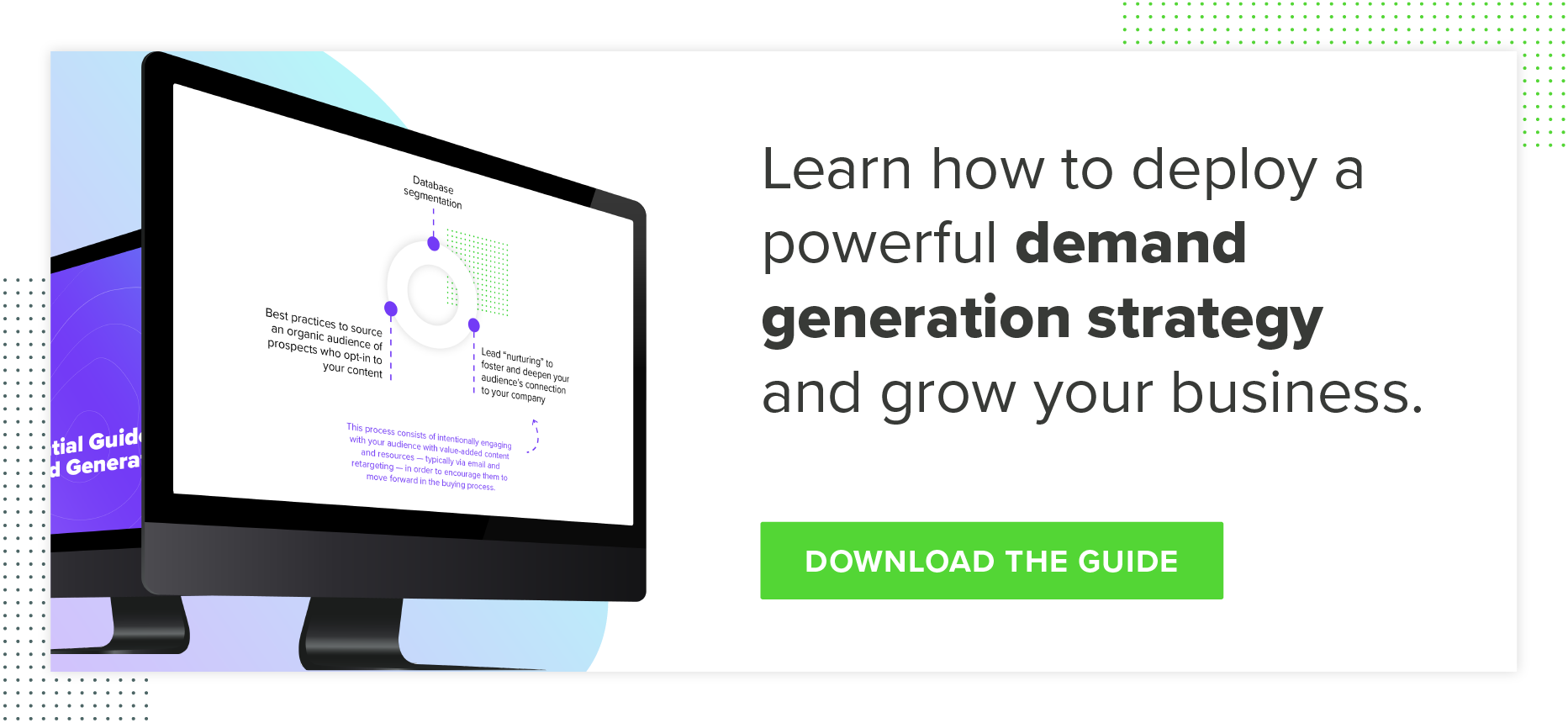
Whether you find yourself launching a new business or seeking to improve an existing one, your marketing efforts need a strong foundation to ensure they’re effective. While new businesses will be building this foundation from the ground up, it’s just as important for established companies to regularly evaluate these areas and how they’re impacting their marketing.
Developing a strong foundation begins with several key elements: a target audience, a brand identity, a sales-ready website and established revenue operations. How these elements interact and inform the others ultimately build out your marketing efforts.
Build Your Target Audience
Before you can get started with marketing, you need to have a robust understanding of your target audience. Your target audience is the object of your marketing efforts. An audience provides a high-level overview of those who will care the most about your product or service including demographic and psychographic information.
When developing your target audience, you should think about your current — or aspirational — customers. Who are they? What do they care about? What are their pain points and challenges?
“People buy from pain points more than anything else,” says Guido Bartolacci, Head of Demand Generation for New Breed. “Your messaging will be built around that.”
Knowing your audience’s pain points will also help answer how your product or service can offer a solution to those challenges. Your marketing efforts will be better served because you can align your offer with the problems you know your audience is facing.
“Once you start answering these questions, you should start documenting your findings into [buyer] personas,” says Guido.
Buyer personas are a semi-fictionalized representation of your ideal customers. They provide context to your customer’s day-in-the-life, their education or different roles they may fill at a company.
As you build out your strategy, your buyer personas will inform your marketing efforts. Instead of determining how a particular tactic aligns with your entire target audience, you can determine whether or not it aligns with an individual persona.
“Once you understand who those people are, you should also consider, especially in the B2B space, what companies that they work for,” says Guido.
Early in your marketing efforts, you may find that buyer personas and companies go hand-in-hand. As you scale over time, your buyer personas may fill multiple roles within different types of companies. Understanding the pain points of your buyer personas and the pain points of the companies they work for can improve your team’s ability to sell.
“If you can align the challenge the individual is happening with how helping them will also help the company, then that builds a better business case for your solution,” Guido says.
Download the Essential Guide to Demand Generation
Craft Your Brand Identity
With a keen understanding of your ideal customers and their challenges, now is the time to position your product or solution to align with those pain points. Your business’ value proposition will establish why your business is the best choice to solve for your customers’ challenges.
Your brand identity which is made up of your tone, voice and design will ultimately determine how your market perceives your brand and subsequently, your product. The research you gathered in building out your buyer personas will directly inform how to curate your identity to best resonate with your audience.
Your brand identity goes beyond how your business looks and sounds, though. What a customer thinks, feels and does when they see your brand should inform your design process.
With that in mind, your branding process should determine the core values of your company and the subsequent attributes of your brand. If your tone, voice and design don’t convey these values or attributes, then it won’t be conveyed to your customers or prospects.
Another important question to ask yourself during the branding process is how you will position your solution against your competitors. What are your competitors doing well? Approaching clients with the same language or positioning as other products in the market will do little to resonate with prospects.
By questioning what competing or aspirational brands are doing well, you enable yourself to effectively position your own brand in the marketplace. The research you collect will inform how you talk about your solution differently or how you will fill in the gaps present in your industry.
Honing in on these details will inform and shape your marketing efforts down the road including your content and design strategy.
Execute a Design Strategy
Now that you have a brand identity in place, you need to design the collateral that will accompany and enrich your marketing efforts. That means email templates, social media graphics, premium content offers and more.
If you think about it as a map, your brand identity is your destination and your design strategy is the route you’re taking to get there. Now that you have attributes and values that you want your brand to convey, you have to craft the design to do so.
Your design serves as a channel through which to communicate your brand identity. When design is working well, it is conveying all the thoughts, feelings and actions you established in your branding process. It should create a perception in the minds of your customers that your business is the best solution to their problem.
How does one actually execute on a design strategy? First and foremost, it’s a good idea to establish a brand style guide. Much like documenting buyer personas to represent your target audience, your brand style guide is the documentation of your established brand identity.
Your style guide sets the rules for your brand including logos, colors, fonts and even the tone of your copy. With a comprehensive style guide, you should have no trouble maintaining visual consistency throughout all of your designs.
From there, your design strategy will encompass the many visuals you need to adequately tell your brand’s story. Even when establishing a foundation for your marketing efforts, design is an ongoing process.
With each design, the question of how it communicates your brand identity should be top-of-mind. While incorporating visual diversity into your design strategy is important to stand out in the marketplace, your design should always emulate your brand’s identity.
With that in mind, here are important considerations to make when executing your design strategy:
- Aesthetic vs. Function: Your design may look fantastic, but does it properly communicate your brand’s message?
- Target Audience: Will this particular design piece resonate with your ideal customers?
- Consistency: Even though you’re incorporating visual variety, can a prospect look at your design and associate it with your business?
- Channels: How does the channel or medium you’re designing for inform and influence your design whether it be digital ads or print collateral?
Establish Your Web Presence
At this point, the foundation of your marketing efforts is coming together. You have clearly defined buyer personas and your design beautifully portrays an established brand identity. The next question is: where does it all live?
“Your website is the vehicle and the place where all of that is stored,” says Guido. “All of your messaging and branding should live there. It’s also the main point you will be driving prospects to with your content and content promotion.”
It’s no question that your website is a phenomenal tool for lead generation. In order to set your website up to do so, you need to incorporate all of the previous sections into its creation. When we build websites at New Breed, we consider how a website can guide a prospect from their pain point to a solution.
For example, let’s say your established buyer persona has a challenge with managing their expanding database of leads and customers. They search for more information about customer relationship management and come across your blog on the subject.
After reading your blog they click on a CTA to download additional content and are now moving further down your funnel.
Designing your website with your customer’s buyer journey and pain points in mind is essential to generating more leads for your business, placing further emphasis on crafting your buyer personas early in the marketing process.
“If you align these things correctly, your website will be a tool to generate leads for you 24/7, 365 days a year,” says Guido.
In short, your user experience design is directly influenced by the buyer personas you have identified. Understanding the pain points and challenges of those personas will determine how you map out your website, establish navigation and organize content into pages to best align with their buyer journey.
From a content perspective, your website houses the design and messaging that you have worked hard to craft up to this point. The tone of your blog, the visuals of your content offers and the overall look and feel of your website are informed by your brand’s identity. Without consistency across these sections, your marketing efforts cannot be well aligned.
Get Your Revenue Operations in Place
Once your website has generated a lead through a content offer download, you have to be able to answer how you continue the conversation. Revenue operations are a significant piece of your marketing efforts, ensuring that process and technology does not interfere with the foundational work you have done up to this point.
“Being able to continue to send relevant information to your leads once they have converted is essential to move them through the buyer’s journey,” says Guido. “That all happens in your marketing automation platform.”
For example, how do you progress a prospect from lead to customer? Just because your website visitor has converted on a content offer doesn’t mean they’re ready for sales. Ensuring that you have captured the right information and enrolling them in an email nurture campaign will keep them engaged with your business.
“If you have collected the right information about your visitor and established the right personas beforehand, your marketing automation platform should be able to send them relevant content because you understand who they are,” says Guido.
Within your CRM or marketing automation platform, persona mapping and lead scoring tools that determine whether or not a lead is the right fit for your business are based on your understanding of your target market.
Additionally, you can establish triggers or notifications to alert your sales team when a lead is deemed fit to move forward with. While these are all tools that can happen in a CRM or a marketing automation platform, your marketing and sales teams may be using different systems.
“The tools your marketing team is using and the tools your sales team is using need to be able to speak to one another,” says Guido. “When your marketing platform determines a lead is a good fit for sales, the sales team needs to be alerted on their platform.”
Your revenue operations provide the organization, documentation and expertise your business needs to function, including the alignment of your sales and marketing platforms.
The Takeaway
It’s important to note that the aspects detailed in this piece are merely the foundation of your marketing efforts. Educating yourself further about buyer personas, branding, user experience and revenue operations is an excellent next step.
Even if you don’t find yourself at the beginning of this process, it’s important to consistently audit and evaluate these different areas. Your business, customer and solution can all evolve over time and so should your brand, personas and website.
Chris Singlemann
Chris is a Brand Marketer at New Breed where he is responsible for crafting design and video assets that support our brand. When he's not behind the camera, he enjoys kayaking and tending to his sourdough starter.

